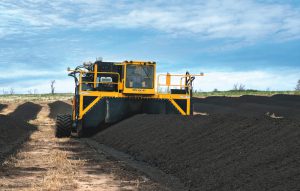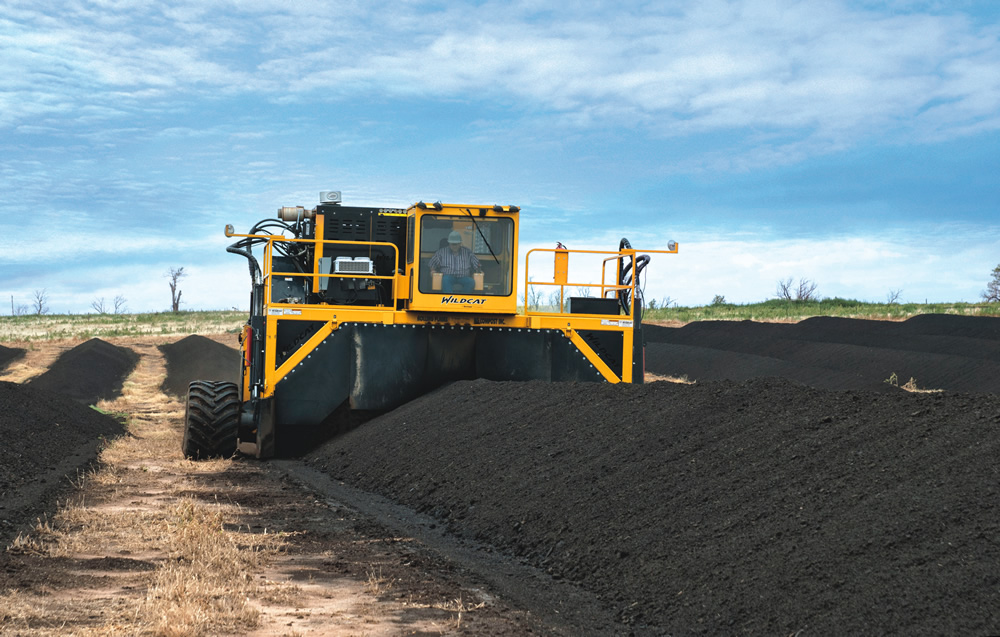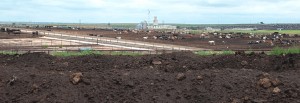Texas-based composter converts feedlot waste into organic fertilizers and soil amendments.
Randy Happel
BioCycle September 2012, Vol. 53, No. 9, p. 48
After birth, calves typically spend the first six to 10 months of their lives on the range alongside their mothers. Once attaining weights ranging from 450 to 700 pounds, the mature calves are weaned and moved to feedlots where they remain until reaching weights desired for slaughter, typically 1,200 to 1,400 pounds. Over the course of the four to six months spent in feedlots, each growing steer and heifer will produce approximately 1.8 tons of manure. With the number of cattle often upwards of 30,000-plus dwelling within one lot, the hefty amount of manure poses concerns for feedlot operators and environmental interests alike.
More stringent regulations imposed by the U.S. Environmental Protection Agency (EPA) and the Texas Water Quality Board over the years on large feedlot operations have created an opportunity for Jack Moreman, a former college instructor on ranch and feedlot management and a feedlot operator. Moreman provides a highly efficient composting service that helps feedlot operators better manage the staggering amount of manure produced by their herds each year. “At the time I was in the feedlot business, we couldn’t give it [manure] away,” he says. “But since then, regulations have stepped up on feedlots — specifically manure and runoff — so it behooves operators to partner with someone like our organization that will remove manure and compost it.” The compost is sold to local farmers as fertilizer and to help with water and moisture retention — a challenge for agricultural operations in this area.
BioCycle Web Extra: Interview with Jack Moreman of Rolling Plains Ag Compost
Moreman’s composting quest began several years ago while working with an Oklahoma-based company that marketed a plant nutrient package made from raw cattle manure. The company grew quickly, and expanded to service feedlots in neighboring Texas and Colorado. Six years ago, Moreman and business partner Don Lyles purchased the Texas-based portion of the company and formed their own — Rolling Plains Ag Compost, appropriately named for the geographic region where the bulk of the feedlots they serve are located. Today, the combined herd population capacity of the seven feedlots served by Rolling Plains Ag Compost is approximately 200,000 head. The company processes more than 720,000 tons/year of manure. With a conversion rate of approximately 5-to-1, Moreman estimates the manure composted each year yields about 300,000 tons of compost.
Composting Logistics
The physical condition of manure extracted from large feedlots is much different than manure historically produced in barnyards where the raw waste is often removed and placed in piles for later use on cropland. In commercial feedlots, largely due to the high density of cattle, the manure is packed to the point that when removed, it is usually in the form of large, compacted chunks. It is difficult to handle, hard on excavation equipment and nearly impossible to spread in a uniform manner on cropland. It is also highly variable in nutrient content, making farmers uncertain of just how much fertilizer value is present in the material applied and at what rate the nutrients will become available for plant growth.

Manure is removed from the feedlot with a bucket loader and hauled to laydown yards adjacent to the individual lots. Windrows are formed approximately 14 to 16 feet wide at the base, and 5 to 6 feet tall.
“The only ingredient that may need to be added is water, depending on the initial moisture content of the manure and weather conditions during the six-week timespan it takes for the compost process to complete,” says Moreman. “The turner enables us to accommodate turning the larger volumes of manure, especially in the compacted form it takes when removed from the feedlot. We provide compost services to seven different feedlots. Our yards are scattered about, so we’ll load the turner on our semitrailer and move it around as needed.” All pens are excavated at least once a year, while many pens, especially in areas where cattle are coming and going a lot, may be cleaned twice annually.
Temperatures of the windrows are monitored continuously, indicating when turning needs to occur. After six turns on average — approximately once every week — the compost is considered finished. Lab analyses are completed at every location and on nearly every windrow to ensure quality and nutrient value.
Agricultural Markets
The recommended application rate for agricultural field use is 4 tons/acre. According to Moreman, at this rate, several important natural nutrients are reintroduced into soils, including 100 pounds each of nitrogen and phosphorous, 120 pounds of potash and approximately 2,000 pounds of organic matter. “The only source of carbon in the soil comes from the organic matter,” Moreman explains. “Carbon has the ability to hold water and nutrients in the soil profile, and allows for more moisture to be available for plant uptake. Without adequate organic matter, water, along with soil nutrients, moves out of the soil profile and becomes unavailable to plants. For every one percent of organic matter content, the soil can hold roughly 16,500 gallons of plant-available water per acre of soil extending down into the profile one foot deep.”
Organic matter also adds humic and fulvic acid — elements that enhance plant decomposition after harvest — along with iron. This is especially important for cotton producers, since the cotton crop returns little if any natural organic matter back into the soil as post-harvest remains degrade.
Rolling Plains Ag Compost offers turnkey services for its customers that include the compost and a fleet of spreaders used for applying the compost soil amendment to their fields. Moreman also supplies local golf courses with compost, albeit a more fine composition than that applicable for agricultural field applications. For golf courses, he screens compost in a trommel with 3/8-inch holes. The particle size resembles small pebbles.
Randy Happel is a writer with Two Rivers Marketing in Des Moines, Iowa.











